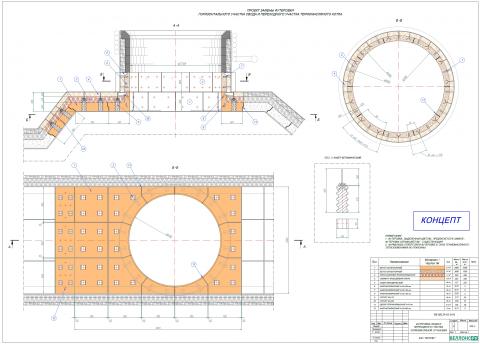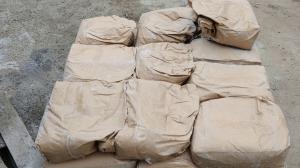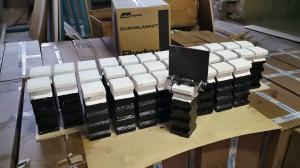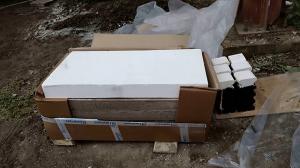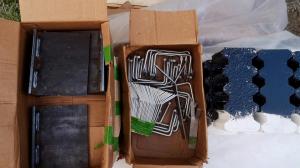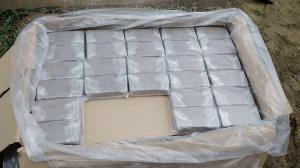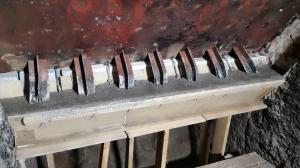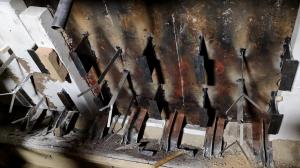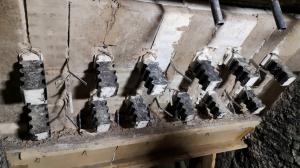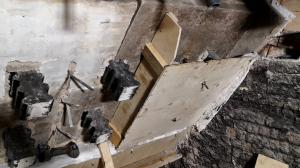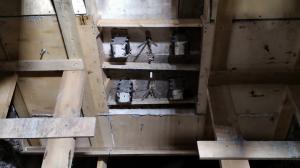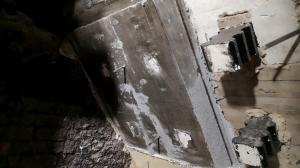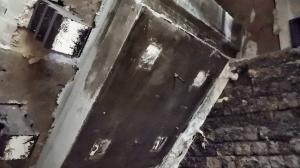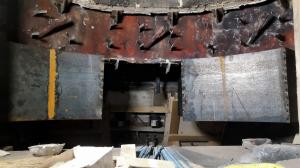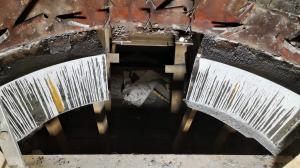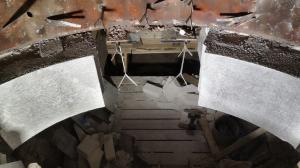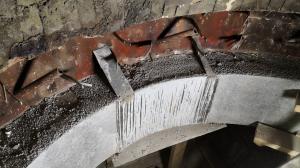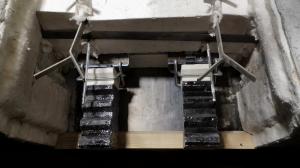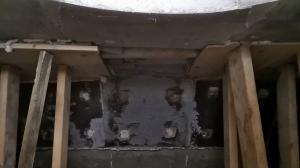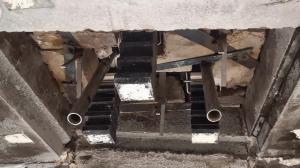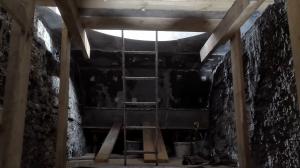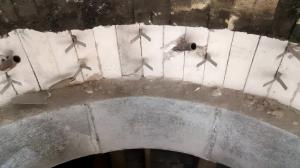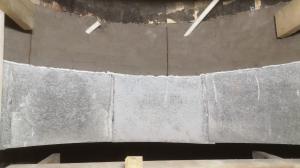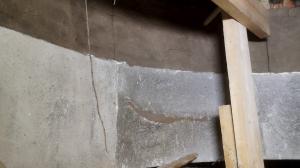25 сентября 2019 года компанией ООО «Веллонс.РУ» успешно завершен проект по замене огнеупорной футеровки свода и переходного участка термомасляной установки (ТМУ-1). Данные работы выполнены на условиях EPCМ-контракта, включая инжиниринг, подбор и поставку материалов, а также проведение шефмонтажа выполняемых работ на соответствие технической документации проекта (монтажные работы выполнялись силами заказчика).
ИНЖИНИРИНГ.
Специалистами ООО «Веллонс.РУ», в рамках данного проекта, были разработаны различные варианты огнеупорной футеровки с применением многослойной конструкции (двухслойная теплоизоляционная футеровка и футеровка рабочего слоя с применением монолитного огнеупорного бетона).
Сложность данного проекта обусловлена необходимостью частичной замены существующей футеровки, ее примыкания к существующей футеровке стен, конструкцией плоского свода с переходным цилиндрическим участком а также необходимостью решения постоянно возникающей проблемы разрушения огнеупорной футеровки на участке наклонного и горизонтального участков плоского свода ТМУ.
ПОДБОР И ПОСТАВКА ОГНЕУПОРА.
Участок плоского свода. Для решения проблемы периодического выхода огнеупора из строя, нами были подобраны аналоги огнеупорных и теплоизоляционных материалов, согласно оригинальному проекту футеровки завода изготовителя ТМУ-1. В качестве огнеупора рабочего слоя использован высокоалюминатный огнеупорный бетон марки BORCAST-70W (толщина слоя 200 мм.) с рабочей температурой применения до 1450-1500 °С, в качестве первого теплоизоляционного слоя – каолиновая плита КТП-70 (в два слоя – 150 мм.) с рабочей температурой применения до 1250 °С, в качестве второго теплоизоляционного слоя – силикаткальциевая плита типа SILBORD (один слой толщиной 100 мм.) с рабочей температурой применения до 1000 °С. Общая толщина футеровки – 450 мм. Для формирования температурных швов применятся рулонный теплоизоляционный материал (одеяло) Durablanket 128 толщиной 10 мм с рабочей температурой применения до 1250 °С.
Для обеспечения конструктивной прочности огнеупорной футеровки в целом, с учетом высокой температуры в зоне применения огнеупора (до 1250°С), нами были разработаны и изготовлены керамические анкера из тиксотропного бетона с высоким содержание Al2O3>80%, имеющих высокую температуру применения и прочностные характеристики. Данные керамические анкера применяются совместно с металлическими анкерами из высоколегированной жаропрочной стали AISI 310S.
Переходной, цилиндрический участок. Для сокращения возможного времени монтажа / устройства огнеупорной футеровки на данном участке, в качестве рабочего слоя применена высокоалюминатная высокоогнеупорная пластичная набивная масса ВЕЛЛ-ПЛАСТ Р85, с содержанием Al2O3>84% и рабочей температурой применения до 1550°С. Данный материал поставляется готовым к использованию и не требует дополнительных работ по устройству опалубок, что позволяет в разы сократить время монтажа данного огнеупора, в сравнении с традиционными «заливными» бетонами. В качестве теплоизоляционного слоя использована силикаткальциевая плита толщиной 100 мм. Для обеспечения конструктивной прочности огнеупорной футеровки применяются металлические анкера из высоколегированной жаропрочной стали AISI 310S.
МОНТАЖНЫЕ РАБОТЫ.
Все работы, связанные с устройством огнеупорной футеровки, велись под непосредственным надзором и с участием специалистов ООО «Веллонс.РУ». Монтаж огнеупора, а также необходимые вспомогательные работы проводились специалистами ЗАО «Муром».
Все основные виды работ описаны ниже в соответствующих разделах. Они также будут представлены в наших кратких видеоотчетах на сайте компании в разделе «ФУТЕРОВКА СВОДА ТЕРМОМАСЛЯНОЙ УСТАНОВКИ».
1. УЧАСТОК НАКЛОННОГО СВОДА ТМУ.
Конструкция футеровки наклонного свода – два слоя теплоизоляции из каолиновой плиты общей толщиной 150 мм и силикаткальциевой плиты толщиной 100 мм.; рабочий слой – из огнеупорного бетона BORCAST-70W толщиной 200 мм. Общая толщина футеровки 450 мм.
Устройство и заливка карт:
Перед началом монтажа теплоизоляционного слоя производится установка подвесных элементов керамических анкеров (4 шт.) и металлических жаропрочных анкеров (3 шт.) для обеспечения крепления огнеупорного бетона рабочего слоя.
В межанкерное пространство укладывается теплоизоляционный слой из силикаткальциевой плиты, подгонкой и пиловкой данного материала, по возможности максимально плотно. Существующие швы заполняются теплоизоляционным одеялом.
Затем, производится укладка каолиновых теплоизоляционных плит в два ряда, по возможности, обеспечивая максимальную плотность между различными сегментами плит.
До начала укладки второго ряда каолиновой плиты на подвесной элемент, при помощи элементов подвески (жаропрочный элемент крепления) производится монтаж керамического анкера с обязательной его расклинкой при помощи пластиковых клиньев, а также стяжки элементов подвески при помощи вязальной проволоки, для обеспечения надежного крепления анкера на период заливки бетона рабочего слоя. Применение пластиковых анкеров – обязательное условие! При наборе температуры, данные пластиковые клинья выгорают и, тем самым, обеспечивают возможность температурного расширения бетона карты и анкера соответственно.
До начала монтажа керамического анкера, данный анкер необходимо подготовить – нанести тонкий слой битумной мастики толщиной ~ 0,5 мм. для обеспечения компенсации теплового расширения бетона рабочего слоя и материала анкера.
Производится монтаж опалубки боковых стенок карты и, соответственно, после окончания монтажа теплоизоляционных слоев и анкеров карты, производится монтаж верхней крышки опалубки на предварительно наваренные резьбовые шпильки, и опалубка раскрепляется дополнительными стойками. Верхнюю крышку, боковые стенки опалубки необходимо промазать отработанным маслом, для обеспечения нормального процесса разборки опалубки и предотвращения прилипания бетона непосредственно к материалу крышки опалубки (фанера, металл).
Производится заливка огнеупорного слоя бетона. Толщина слоя 200 мм. при использовании глубинного вибратора.
Наклонный свод состоит из трех карт – в первую очередь заливка бетона производится в две крайние карты. После выдержки бетона (10-12 часов) опалубка аккуратно снимается. Средняя карта подготавливается к заливке по процедуре, описанной выше. Карты заливаются параллельно с другими картами (карты переходного участка / вход в цилиндрическую часть ТМУ).
Перед окончательной сборкой опалубки средней карты наклонного свода, производится наклейка ленты из теплоизоляционного одеяла (шириной 200 мм.) на ранее сформированные стенки карт, для формирования температурных компенсационных швов.
Примыкание футеровки стен и вновь укладываемого огнеупора также прокладывается теплоизоляционным одеялом на ширину футеровки стен – формируется температурный шов.
2. ПЕРЕХОДНОЙ УЧАСТОК СВОДА ТМУ.
Конструкция футеровки переходного участка свода – два слоя теплоизоляции из каолиновой плиты общей толщиной 150 мм и силикаткальциевой плиты толщиной 100 мм.; рабочий слой – из огнеупорного бетона BORCAST-70W толщиной 200 мм. Общая толщина футеровки 450 мм.
Устройство и заливка карт:
В связи со сложной геометрией карты – переход горизонтального участка в вертикальную плоскость, при одновременном сохранении радиуса вертикальной части, детали опалубки карты изготовлены заранее, по чертежам Веллонс, из листового металла толщиной 2 мм. со сборкой опалубки по месту.
После установки вертикальных ребер/стен опалубки производится установка анкерной продукции (керамических и металлических анкеров), устройство теплоизоляционных слоев согласно процедуре, описанной в разделе 1.
На переходном участке до начала заливки бетона, производится подготовка одновременно пяти карт (через одну), что позволяет ускорить процесс заливки бетона.
После выдержки бетона в течении 10-12 часов, опалубка снимается и производится монтаж опалубки (включая работы по устройству теплоизоляционных слоев, установки анкеров, устройство температурных швов) оставшихся пяти карт и их заливка огнеупорным бетоном рабочего слоя при помощи глубинного вибратора.
3. УЧАСТОК ПЛОСКОГО СВОДА ТМУ.
Конструкция футеровки прямого свода – два слоя теплоизоляции из каолиновой плиты общей толщиной 150 мм и силикаткальциевой плиты толщиной 100 мм.; рабочий слой – из огнеупорного бетона BORCAST-70W толщиной 200 мм. Общая толщина футеровки 450 мм.
Устройство и заливка карт:
Аналогично разделу 1 – заливка карт наклонного свода.
Порядок заливки карт – в первую очередь заливка двух боковых карт, центральная карта – заливается последней.
Для удобства заливки карты плоского свода, после всех подготовительных работ и установки опалубки, заливка производится в заранее вырезанные отверстия в потолочной части корпуса ТМУ с использованием глубинного вибратора.
4. ЦИЛИНДРИЧЕСКИЙ УЧАСТОК ТЕПЛООБМЕННИКА ТМУ.
Конструкция футеровки – один слой теплоизоляции из силикаткальциевой плиты толщиной 100 мм.; рабочий слой – из огнеупорного бетона (набивная масса) ВЕЛЛ-ПЛАСТ Р85 толщиной ~120 мм. Общая толщина футеровки 220 мм.
Устройство и заливка карт:
После окончания заливки карт бетона переходного участка производится монтаж теплоизоляционного слоя из силикаткальциевой плиты толщиной 100 мм. Параллельно производится установка анкеров из жаропрочной стали.
На поверхность бетона переходного участка, для формирования температурного шва, укладывается теплоизоляционное одеяло шириной 130 мм.
Поверх данного одеяла укладываются готовые брикеты ВЕЛЛ-ПАЛАСТ и «пробиваются»/трамбуются при помощи резиновой киянки и пневматической трамбовки. Масса укладывается и трамбуется по всей высоте карты (~400 мм) послойно. Высота слоя равна толщине брикета (65 мм.).
После укладки всего необходимого объема пластичной массы формируются температурные швы методом пробивки или поперечного реза на глубину 70 мм.
РЕКОМЕНДАЦИИ:
По завершению всех футеровочных работ основным фактором надежной работы огнеупора является его сушка, которую необходимо выполнить согласно выданного графика сушки футеровки. Обращаем внимание, что весь оставшийся огнеупорный и теплоизоляционный материалы, а также ассортимент анкерной продукции необходимо разместить на складе на период гарантийных обязательств ООО «Веллонс.РУ». Данный материал должен быть доступен при наступлении гарантийного случая.
Примечание: считаем необходимым отметить, что при разборке опалубка боковой карты переходного участка, произошло смещение небольшой части бетона с образованием небольшой раковины. Данная раковина была в последствии заделана пластичным огнеупором ВЕЛЛ-ПЛАСТ. Данный участок не несет в себе критических моментов для нормальной эксплуатации футеровки.
Организационные вопросы: 18.09.2019 года специалистами комбината было принято решение не разбирать часть бетона существующих карт свода и переходного участка (со стороны выгрузки материала) в виду крепости существующей конструкции. В последствии, после заливки средней карты переходного участка, было решено вернуться к первоначальному проекту, что внесло свои трудности при работе и, соответственно, потере времени. Несмотря на это, конструкция карты соответствует всем необходимым требованиям эксплуатации оборудования.
